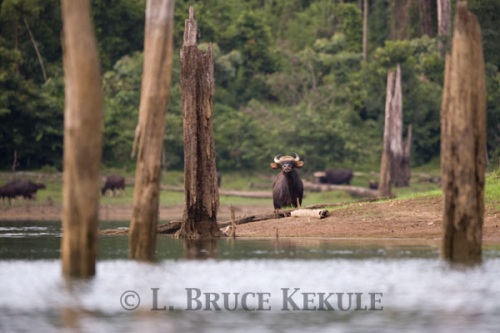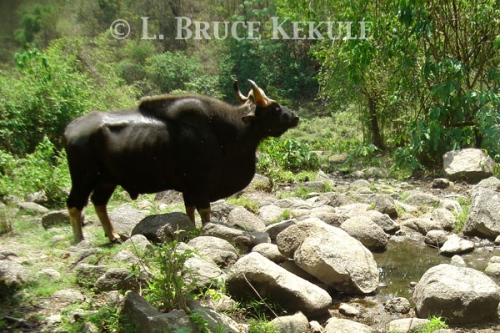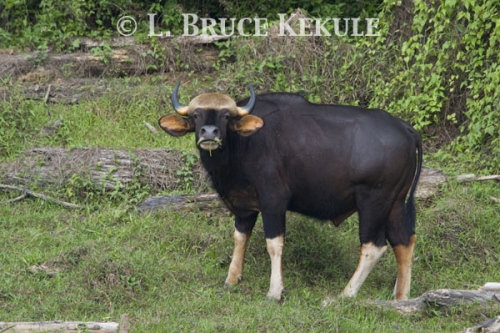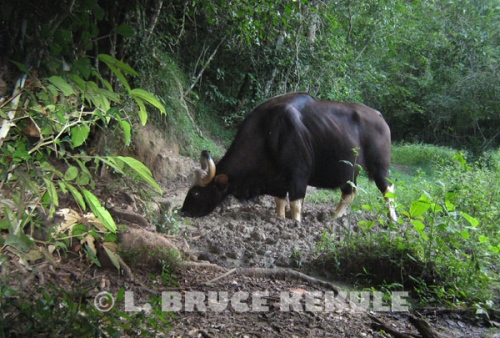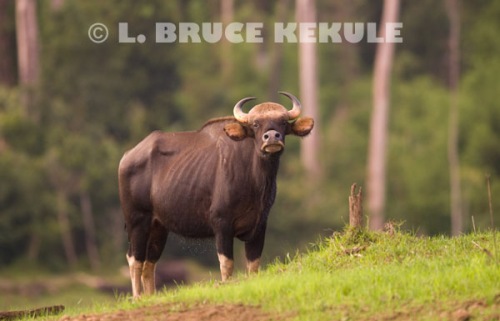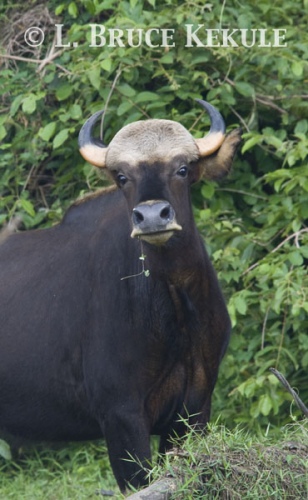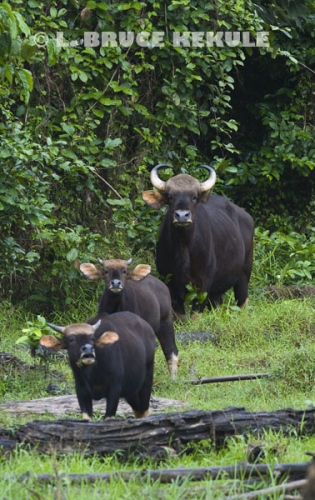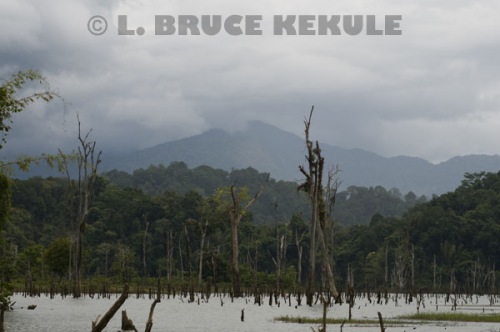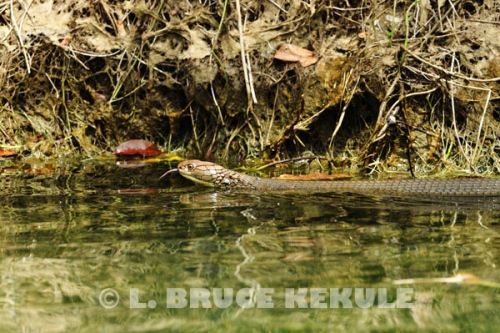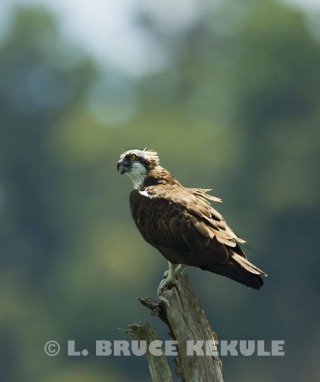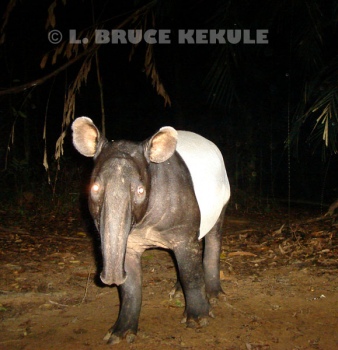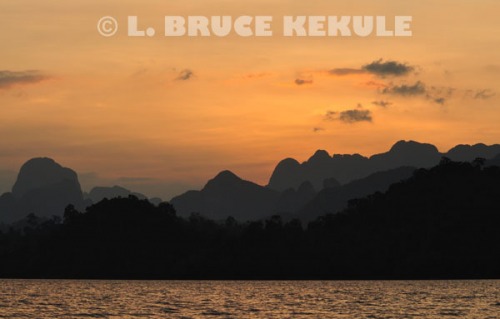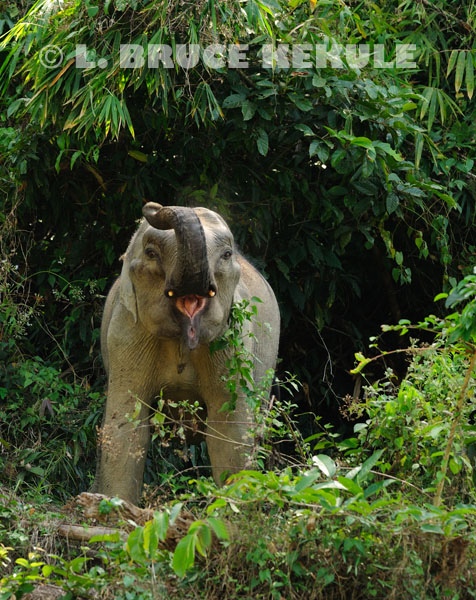Posts Tagged ‘Klohng Saeng’
Gaur – Majestic Wild Forest Ox
WILD SPECIES REPORT
Rare mammal and the largest bovid in the world
Endangered wild cattle close to extinction
Gaur cow in Khlong Saeng Wildlife Sanctuary
About 20 million years ago, the first ungulates evolved from small, hornless deer-like ancestors. Cattle, sheep, antelopes and goats are grouped together in the family Bovidae, and the most common hoofed grazing animal seen today. Sometime during the Pleistocene Epoch 1.8 million years ago, the genus Bos evolved in Asia and spread to Europe, Africa and eventually North America. Gaur Bos gaurus is a descendent of Bos Bibos, a wild cattle that lived on the great plains of Asia. Saber-toothed cats were one of the top carnivores at the time, and evolved alongside the ancient herbivores.
Gaur calf in Khlong Saeng Wildlife Sanctuary
Gaur, the largest bovid in the world, is threatened with extinction and deserves much greater attention. The tiger and elephant have taken most of the conservation spotlight but gaur, like all the other wild animals need just as much protection, research and concern. Unfortunately, these wild forest ox continue to vanish from the wilderness areas in the Kingdom. After years of poor protective management and neglect, poaching and trophy hunting, plus a disappearing habitat suitable for these enormous creatures once found throughout Thailand, is the main reason for the decline.
Over their entire range, they are classified as internationally threatened. But not all is lost as gaur still survive quite well in a few of Thailand’s top protected areas in fair numbers, and where there are true safe havens, the species has actually made a come back. It is now estimated that more than a 1,000 individuals remain in Thai forests. This number is up from the 500 recorded in Dr Boonsong Legakul and Jeffery McNeeley’s book Mammals of Thailand published in 1977. Dr Sompoad Srikosamatara and Varavudh Suteethorn published a paper in the Siam Society’s Natural History Bulletin in 1995 about gaur and banteng. Their estimate then was about 1000 gaur were surviving so the number is basically stable and most likely on the increase.
Gaur herd at a mineral deposit in Huai Kha Khaeng Wildlife Sanctuary
In Southeast Asia and India, gaur is found in scattered and splintered habitats. Other large wild bovine are banteng and wild water buffalo of Southeast and Southern Asia, the yak of Central Asia, the cape buffalo of Africa, and the bison of North America and Europe. In recent times, the number of these wild creatures has dwindled as humans continue to hunt them for meat and trophies, and destroy and encroach on their habitat in some places. The American bison came close to extinction but was saved in the nick of time. Thousands of wild bison now survive due to conservation efforts initiated by many people including the late U.S. President Teddy Roosevelt.
Gaur is Thailand’s second largest terrestrial animal after the elephant and tends to inhibit deep mountainous terrain far from humans. They survive in dry and moist evergreen forest plus mixed deciduous forests and therefore, have fared better than their cousin, the banteng that live in more open lowland forest. Gaur occasionally mixes with banteng that has been documented in Huai Kha Khaeng Wildlife Sanctuary, Uthai Thani province. Gaur will also shadow elephant herds using the same trails made by the larger mammals.
Gaur herd in Khlong Saeng
My favorite photographic wildlife subject is gaur. In Thailand, these majestic ungulates can still be found in the following places: the Western Forest Complex and Kaeng Krachan Forest Complex, both in the west; the Khao Ang Rue Nai Forest Complex in the east; the Dong Payayen – Khao Yai Forest Complex and the Phu Khieo – Nam Nao Forest Complex, both in the Northeast; and down south in the Khlong Saeng – Khao Sok Forest Complex. Due to the serious instability in the deep south, very few surveys have been carried out and there is no consensus on gaur but they do survive in the Hala-Bala Forest Complex situated along the border with Malaysia. It is doubtful if any gaur survive in the North but the Omkoi – Mae Tuen Forest Complex might have few left.
Gaur has a keen sense of smell and hearing, and is always alert for danger. As a result, they can be tough to spot in the dense forests of Asia. However, luck does come sometimes, and the following accounts describe the few times I have had the great fortune to observe these magnificent beasts in the wild.
Gaur bull camera-trapped at a mineral lick in Huai Kha Khaeng
My first photographic encounter with gaur in 1986 was at the beginning of my career as a wildlife photographer deep in the interior of Huai Kha Khaeng Wildlife Sanctuary. A natural deposit or mineral lick several hours walk from the road attracts many animals – gaur, banteng, elephant, sambar and muntjac come for the life-giving minerals, plus tiger, leopard and Asian wild dog hunt for prey. The balance of nature runs in harmony where “eat or be eaten” is the rule. I was extremely lucky and photographed two mature bull gaur that arrived late one afternoon as the sun was setting. The old bull on the front cover of my first book ‘Wildlife in the Kingdom of Thailand’ stayed at the waterhole for quite sometime and I shot several rolls of film. This place has always been special to me.
A year later, I began visiting Thung Yai Naresuan Wildlife Sanctuary along the western border with Burma specifically to photograph gaur. In 1985, a herd of more than 50 individuals was seen from a helicopter by park officials on the huge grassland in the center of the sanctuary. Thung Yai is a tough place to work as many mining trucks plus off-road 4X4 enthusiasts with big tires and jacked-up truck chassis have abused the road into the sanctuary for many years. Deep ruts in many areas make travel along the road difficult even for normal off-road vehicles. The rangers have a real rough time patrolling this sanctuary.
Young gaur bull in Khlong Saeng
On one of my many trips to Thung Yai, and after many grueling hours of travel, and then a couple hours’ walk to a mineral lick in the sanctuary, I set-up a photographic blind along the forest perimeter. Late in the afternoon, two bachelor bulls entered and drank from the spring at the top end. I managed to get some good photographs as they went about their business. One bull snorted at our position as I had placed fresh gaur droppings in front of the blind, and I believe he was just letting us know who he was. Both bulls then departed peacefully and I was elated to say the least. It is estimated that more than 100 individuals thrive in Thung Yai.
In October 2008, I began a camera-trap program and set several units at a mineral lick visited by gaur and elephant in Kaeng Krachan National Park in Phetchaburi province, southwest Thailand. A month later, I visited the park and collected the cameras. A herd of gaur had come to the deposit including several cows and their offspring. It seemed as if the camera had spooked them initially, but the herd came back again the next day and a long series of captures was obtained. There are about 70 of these beautiful creatures thriving and breeding in this protected area.
Over in Huai Kha Khaeng Wildlife Sanctuary in the west during December 2008, I also set some digital camera-traps at a water hole, and after one month, two gaur bulls visited the waterhole. I also sat by the river in a photo-blind across from another mineral lick and photographed a large herd of gaur that had come for the minerals and lush grass. It is estimated that 350 gaur survive in this sanctuary. Better protective measures have allowed gaur to breed profusely and this World Heritage Site lives up to its name. Predators like tiger and wild dogs capable of taking on gaur, also thrive here. In the whole of the Western Forest Complex, it is estimated that more than 500 individuals live in scattered areas covering some 15,000 square kilometers.
Gaur cow camera-trapped at a mineral lick in Kaeng Krachan National Park
Early this year while photographing wildlife in Khlong Saeng Wildlife Sanctuary in Surat Thani province down south, I had an amazing journey of discovery. Deep in the protected area, gaur is still thriving quite well. I set camera-traps in the sanctuary and managed to capture a very old bull gaur and several herds at many locations. A close look at the photograph shows seriously worn hooves on his hind feet. He is definitely past his prime and would not be a contender for female gaur in heat. With poor traction, he could not fight the younger bulls with stronger hooves and horns.
I also toured the flooded forests of Khlong Saeng and Khlong Ya rivers created by the Chiew Larn or Ratchaprapra Dam using a boat-blind and silent electric trolling motor. I was able to approach many herds and individuals over a four-month period. In every herd, there were young calves and yearlings indicating a healthy breeding population. Most of the mature bulls have become nocturnal due to past and present poaching pressure in the reservoir. In the Khlong Saeng – Khao Sok forest complex, it is estimated that more than 100 gaur are thriving.
In Kui Buri National Park, Prachuap Kirikan province, gaur has definitely made a come back due to increased awareness by the park staff plus financial support extended to help the rangers. It is now estimated that the population of gaur is about 70 individuals. Khun Chalerm Yoovidhya, MD of the Huai Hin Hills Vineyard and Siam Winery has taken a special interest in gaur at Kui Buri. Working with the park officials, he has funded many projects to help these creatures by sending volunteers to plant grass in selected areas to propagate grasslands, and setting up salt licks and check dams to attract the herbivores. Other projects initiated by Khun Chalerm include selling wildlife photographs and paintings at the vineyard to help the park rangers with food, clothing and equipment giving them more incentive to patrol the forest. Over time, other areas will put on the list for special help to protect Thailand’s natural heritage from the damaging effect of human poaching and intervention.
Gaur spooked by camera-trap in Kaeng Krachan
In the northwest section of Thap Lan National Park, my very close friend Gate Glomchum who worked for the Petroleum Authority of Thailand (PTT) as chief reforestation officer (retired) did some amazing things during his career as a reforester. Prior to 1996, a 10,000 rai area in Wang Nam Kheaw was completed degraded by a logging concession and squatters. Under his management and following a mandate set by His Majesty the King, this forest was replanted and the people were moved out. Today, this forest has completely grown-over, and there is elephant, gaur and tiger plus many other classic Asian species living in total harmony with nature. Other areas in Thailand also reforested under his supervision have had similar success.
Over in Khao Phang Ma just outside the eastern part of Khao Yai National Park, a national forest reserve was reforested by Wildlife Fund Thailand (WFT) and Khun Suthirat Yoovidhya (Director of CSR) of Red Bull-Thailand fame. Gaur moved back into this forest from Khao Yai after protective measures increased. There are about 50 gaur at this location and is probably the only place in Thailand where gaur live outside a protected area. Many projects like helping the rangers, setting-up salt licks and check dams have also been funded by Khun Suthirat under the ‘Red Bull Spirit’ program that is on-going. A couple of years ago, WFT shutdown all conservation operations due to internal conflicts but the Department of National Parks, Wildlife and Plant Conservation (DNP) took over responsibility of the reserve. They should be commended, and it is reassuring that some people are serious about conserving the Kingdom’s natural heritage.
Gaur herd camera-trapped at a mineral lick in Kaeng Krachan
In the long run, the importance of protecting a prey species like gaur should be the number one priority for the government. The DNP need to increase budgets and personnel to look after these forests and animals. Thailand remains one of the best places for the survival of gaur in Southeast Asia. Protection, conservation awareness, education and monetary support are the keys to the future of these magnificent creatures of nature, and it is hoped they will continue to live in their natural habitat far from the destructive forces of man.
Ecology and Behavior
Gaur is the largest bovid in the world with a distinctive dorsal ridge and a large dewlap, forming a very powerful appearance. A fully mature bull stands about 1.6-1.9 meters at the shoulder and average weight of a big bull is 900 kilograms on up to a ton. Cows are only about 10cm shorter in height, but are more lightly built and weigh 150 kilograms less. These even-toed ungulates have stout limbs with white or yellow stockings from the knee to the hoof. The tail is long and the tip is tufted. Newborns are a light golden color, but soon darken to coffee or reddish brown. Old bulls and cows are jet black but south of the Istamas of Kra, many take on a reddish hue.
All bovine share common features, such as strong defensive horns that never shed on males and females, as well as teeth and four-chambered stomachs adapted for chewing and digesting grass. Their long legs and two-toed feet are designed for fast running and agile leaping to escape predators. They are gregarious animals, staying in herds of six to 20, or more.
Due to their formidable size and power, gaur has few natural enemies. Leopards and Asian wild dog packs occasionally attack unguarded calves or unhealthy animals, but only the tiger has been reported to kill a full-grown adult. Gaur grazes on grass but also browse edible shrubs, leaves and fallen fruit, and usually feed through the night. They also visit mineral licks to supplement their diet. During the day, they will rest-up in deep shade.
There are three separate sub-species of gaur: Bos gaurus gaurus of India and Nepal, Bos gaurus readi of Indochina and Bos gaurus hubbacki of Southern Thailand and Malaysia. However, in 1983, the zoological classification of both the Indochinese and Southern gaur was changed to Bos gaurus laosiensis. In 1993, Pleistocene fossil evidence of Bos gaurus grangeri, an ancient sub-species, was uncovered by G.B. Corbet and J.E. Hill in Sichuan province, China.
Khlong Saeng: The Lost River
One of the Kingdom’s top wildlife sanctuaries still harboring many endangered but classic Asian animals
The weather is mostly clear as the sun drops behind a huge cloud close to the horizon. Light monsoon rains have begun at the end of April but hang in the mountains to the west. It has been a scorcher and heat from the day lingers over the reservoir. The light is soft and warm. About 6pm, a small herd of gaur drift out of the forest to drink at the waters’ edge and forage tender new grass. In a boat-blind about a kilometer away, I silently motor the craft closer using a battery operated trolling motor. The timing is perfect as I move in for a shot of Thailand’s magnificent but endangered wild ox.
Gaur cow in late afternoon light in Khlong Saeng
As I get closer, a mature cow feeding on an island in the lake sees something moving 100 meters offshore, and swims across to the mainland to investigate, all the time keeping her eyes locked on the strange anomaly moving in the water. Water drips from her underbelly, and her reddish-brown coat and deeply curved horns standout in the late-afternoon magic. I fire off a salvo of images hoping my camera and lens will capture this beautiful creature so late in the day. For a few brief moments, the old cow showcases Thailand’s natural heritage.
Young gaur bull
There are many beautiful forests in the South, but one in particular is truly a tribute to nature. Khlong Saeng Wildlife Sanctuary was once a magnificent natural watershed that provided water throughout the year to the inhabitants of the lowlands on the east side of the Thai Peninsula. It still harbors some very impressive animals such as elephant, gaur, tapir, serow, sambar, clouded leopard, sun bear, Great Argus (second largest of the pheasant family in Thailand), and the mighty king cobra – and the list goes on.
Gaur calf
Royal Decree encompassing 1,155 square kilometers of dense forest established Khlong Saeng in 1974. The sanctuary is the biggest in the Khlong Saeng – Khao Sok Forest Complex totaling more than 5,316 square kilometers and incorporating 12 protected areas, 11 of which are terrestrial and one with offshore islands in the Andaman Sea. Its forests are predominantly moist evergreen and most of the plants and animals are of Sundaic origin with some Indochinese species interspersed.
Curious gaur cow
Situated in the provinces of Surat Thani, Phang Nga, Ranong and Chumphon, the complex includes: Khlong Saeng, Khlong Yan, Khlong Naka, Khuan Mai Yai and Ton Pariwat wildlife sanctuaries, and Khao Sok, Kaeng Krung, Lam Son, Sri Phang Nga, Khao Lampi – Hat Thai Muang, Khao Lak – Lam Ru and Khlong Phanom national parks. They are under the responsibility of the National Parks, Wildlife and Plant Conservation Department (DNP) to provide protection, management and staff.
Gaur in the late afternoon
Khlong is the southern Thai word for a tributary or canal. The main tributaries of the Khlong Saeng valley include the Saeng, Ya, Yan, Ake, Mon, Ye and Mui that made-up the mighty Khlong Pasaeng. This river ran wild from the Phuket Range down to the Mae Tapi River in Surat Thani and eventually into the Gulf of Thailand. The riverine habitat teamed with flora and fauna, and the ecosystem was absolutely pristine. Tigers and leopards lived alongside many prey species like sambar, muntjac and wild pig. Elephants and gaur were fairly common. It was a magnificent wilderness at one time.
Gaur cow and her calves
But in the mid-1980s, a drastic change to the Pasaeng River was to come about. To increase Thailand’s electrical power needs, and back when building hydroelectric dams was in vogue, it was decided by the Electrical Generating Authority of Thailand (EGAT), a state enterprise, and the government, to construct the Rajaprabha Dam that eventually inundated a total of 165 square kilometers (65 sq. miles) of the Khlong Saeng valley to become the Chiew Larn reservoir in 1986. The water body extends into the sanctuary for more than 50 kilometers (30 miles) but is only about two kilometers at its widest point.
Flooded forest in Khlong Saeng
Where rivers and forest previously existed, large waterways now provided easy boat access to virgin wilderness. The skeletal forms of what were once huge forest trees stand as a reminder of what disappeared beneath the flood more than a quarter of a century ago. Some trees still stand but many have come crashing down especially up-stream where decaying is severe. Millions of plants and animals perished as the floodwaters rose. The late Seub Nakhasathien, one of Thailand’s hero’s of wildlife conservation plus rangers and wildlife researchers saved hundreds of stranded fauna caught on islands. There are some 160 of them scattered throughout the reservoir when water levels are low. Some denizens were able to swim and move to higher ground but not all. It was the beginning of a new ecosystem – a large lake with a very long and complicated shoreline.
White-bellied sea eagle with a fish
Probably the most impressive scenic site in the sanctuary is the massive limestone ‘karst’ formations that were formed sometime during the mid to late Permian over 200 million years ago. It was a time of widespread mountain-building and volcanic activity. Thailand was part of Gondwanaland that was still attached to Pangaea, the ‘Supercontinent’. These colossal outcrops, some reaching as high as 960 meters (3,150 feet), look almost ‘architectural’ in design and are as impressive as the famous towers in Phang Nga Bay to the south. These configurations are the remnants of a prehistoric coral reef that once thrived here.
King cobra hunting for prey
Of all the animals in Khlong Saeng, gaur is probably the icon of wildlife in the sanctuary. These bovid are now rare in Thailand surviving only in a handful of protected areas, but they thrive fairly well. However, this only occurs around the upper reaches of Khlong Saeng and several other tributaries. The population of gaur here is estimated to be about 100 individuals and is one of the Kingdom’s best reserves for the species due to the dense moist evergreen forest.
Osprey in the mid-day heat
Breeding seems to be healthy; as many calves and young gaur of various ages have been seen in several herds I photographed at this site. Large solitary bulls keep the herd in stable breeding condition. These herbivores need huge tracts of forest free of human presence to survive. Being extremely shy, these wild cattle flee on the first sign of man. Good availability of food, water and minerals are important to their survival and the sanctuary provides these in abundance. There are still some elephants but their numbers seem to have declined. Further downstream, human activity has all but obliterated the large mammals including the tiger, which has not been seen for more than twenty years, even after extensive camera-trap surveys carried out by the research unit at the sanctuary headquarters.
Young Asian Tapir camera-trapped
Next door to Khlong Saeng is Khao Sok National Park covering 739 Square kilometers established in 1980. Khao Sok is well known around the world. The national park’s mandate in Thailand is to promote and encourage tourism into various nature sites within the protected area. After the Rajaprabha dam was completed, boats and wooden rafts were built at an alarming rate to accommodate this new business of boating visitors into the lake. Now there are hundreds of craft, many extremely noisy. Fishing was allowed and it was a free-for-all in the beginning with everyman for himself. All forms of fishing were used including explosives, electricity, nets, trap-lines and spear guns. Many areas were quickly depleted of fish, and fisherman must now venture deeper into the reservoir trying to eek out a living.
Old bull gaur camera-trapped
Actually, the Fisheries Department (FD) has a regulation in place that states ‘no fishing’ is allowed from the dam five kilometers to the limestone cliffs during the breeding season from 15th May to 15th September. This ban should extend completely into Khlong Saeng. Unfortunately, there seems to be little or any formal protection in place as boats and people come and go with no restrictions. Also, in Khao Sok, there are many rafts that have extensive facilities including a ‘karaoke’, which seems distant from nature. Every year the FD releases several species of fish into the reservoir. The ‘giant catfish’, a species found in the Mekong River, was released here and are most likely competing with other large resident fish. The FD has banned its capture but all fish are being caught for the pot, or sale to waiting ice vendors at the dock.
Dusky langur on a stump
However, a more serious problem exists that needs immediate attention before it is too late. When the Rajaprabha hydroelectric dam was finished and working on-line, EGAT passed a regulation and transferred protection duties to Khao Sok National Park. This included the complete waterway and 100 meters up into the terrestrial landscape meaning the entire water body intrudes deep into Khlong Saeng Wildlife Sanctuary for more than 50 kilometers and the mandate for its use and protection is controlled by the national park. People easily penetrate Khlong Saeng to poach, gather and fish, and the sanctuary officials have no authority on the waterway. Budgets are low and therefore, protection and enforcement is minimal. It is an extremely large loophole that needs to be fixed soon!
Gaur cow feeding on grass
EGAT, DNP and FD should join forces to find a viable solution, and take corrective steps to re-zone the reservoir. The solution is easy. About 20 kilometers into the lake at the mouth of Khlong Mon, the lake narrows down to about two hundred meters across. A rope barrier and guard post has been erected by the sanctuary but is unmanned for the most part due to the national park’s mandate. Constant overfishing and visitation to the upper reaches of Khlong Saeng over the long run will definitely have a serious impact on this sanctuary, especially gaur due to their very shy nature. Another very sensitive species is the Great Argus. These beautiful birds will abandon a breeding site if disturbed by humans. There are six hornbill and two gibbon species indicating a pristine forest. Stump-tailed macaque is the largest primate and dusky langur or leaf-monkeys are common. White-bellied sea eagle, lesser fish-eagle and osprey plus otters depend on fish and even though there is still some species in abundance, saturation fishing will eradicate most fish over time.
Sunset over the Khlong Saeng Wildlife Sanctuary
The DNP’s mandate for ‘wildlife sanctuaries’ is straightforward; they have been set aside for wild species propagation, biodiversity research and habitat preservation. With hundreds and possibly thousands of people visiting Khlong Saeng every year, it is doubtful whether the sanctuary can sustain its habitat diversity over the long term. Also, trash and oil pollution from the boats is serious problem that needs attention and constant surveillance.
Khlong Saeng Wildlife Sanctuary is a beautiful but forbidding forest, and its incredible biodiversity it a tribute to the Kingdom’s natural heritage. In terms of research, very little is actually known about the interior but its future depends on many things. Most of all; the protected area should become the focus of attention so that all concerned may take a hard long look and save it for the future. Decisive and quick action in the only recourse before it is too late.
In the field:
After more than a decade of visiting forests in the East, West and North, I decided it was about time I went down South. From January 2009, I began a photographic and camera-trap program in Khlong Saeng Wildlife Sanctuary. Over the course of five months, a trip every month was scheduled. On the very first outing, we arrived at our final destination after a four-hour boat ride. I jumped onto a floating raft (ranger station) not far from the headwaters of the Khlong Saeng. After a few minutes of unpacking and getting settled in, someone shouted out that an elephant was by the waters’ edge across from the ranger station in plain sight.
Young tusker elephant in Khlong Saeng
What a strange bit of luck. We immediately jumped back in the boat and crossed over to where a young tusker was feeding on bamboo leaves and occasionally taking a drink from the lake. He was alone and we could not figure out why. Possibly the herd bull or an old belligerent cow elephant had pushed him out. We will never know. This little bull was in good condition and looked fine. The next day, I was back at the same spot waiting but he did not show. The morning after, he was back. I left the next day but before we parted company, I decided to name him ‘Nong Saeng’ after the river. I thought that would be the last time I would see the little youngster.
Young bull gaur
A month later I was back at the station and the first thing I asked; where was ‘Nong Saeng? No one had seen him. Two days later about 4pm while I was traveling up-river in my boat-blind, I bumped into him again, but much farther into the reservoir. He was back by the shoreline feeding and I was elated to say the least. I stopped the boat and had a great time photographing this lively young elephant once again. He was seen a couple more times by the rangers but since then, ‘Nong Saeng’ has probably gone up into the hinterland as the monsoon rains have begun. This encounter will always create fond memories of nature’s little quirks and how things work out sometimes. Hopefully, I will get a chance to see him again next year in January when I return to continue documenting the wildlife at Khlong Saeng.





